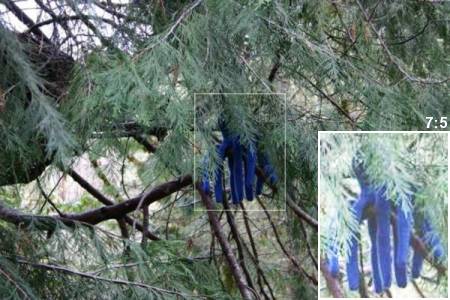Newly added to the Tree Octopus sightings: Marc L. sent in a photo of a rare tree octopus that specializes in redcedar:
Here is a rare and endangered Cephalopod Thuja Pilcata or locally known as the Western Red Cedar Climbing Octopus. You don't see one of these babies everyday!! Especially this far inland!!
Emacs!

Photo detail enhanced using advanced ZPi cephalopod-image processing
technology.
Marc has his names a bit confused, which is understandable given the esoteric nature of tree octopus cladistics. Thuja plicata is actually the scientific name for the Western Redcedar tree that this octopus calls home. The correct binomial for the octopus itself is Thujoctopus pilosa, named for the lush coating of bluish velvet that it evolved to help retain moisture as it migrated deep inland from its ancestral Pacific home. Unfortunately, this notable trait led to its current rarity.
Originally considered a cheaper domestic alternative to fine velvets imported from Italy or Kashmir, redcedar octopus pelts became popular in the early to mid 20th century with a growing North American middle-class desperate for luxury goods. In particular, evening dresses made entirely of undyed T. pilosa pelts became such a fixture during the post-war period that they were immortalized in the song "Blue Velvet" -- made a hit in 1951 by Tony Bennett and again in the 1960s by Bobby Vinton.
(The song also featured prominently in the 1986 film "Blue Velvet" by director and animal lover David Lynch, who considered it emblematic of the moral degeneracy of suburban middle-class life. Lynch spent much of his childhood in the woods of eastern Washington and was well aware of the devastation brought against the local tree octopus populations by the twisted, fetishistic desires of the suburbs.)
Eventually, shrinking numbers of redcedar octopus combined with inexpensive mass-produced synthetic velvets available on the burgeoning global market led to the pelt trade becoming unprofitable -- narrowly saving T. pilosa from extinction.
UPDATE 2007-01-01: Marc sent another picture showing a breeding colony of "Cedar Pus", as locals call them.
